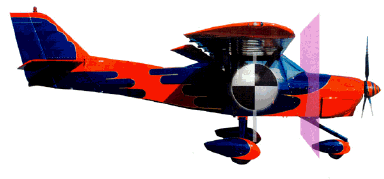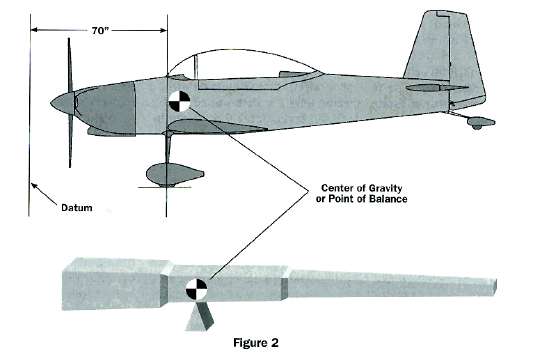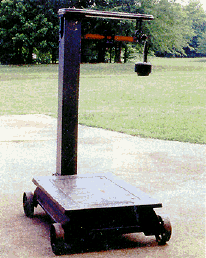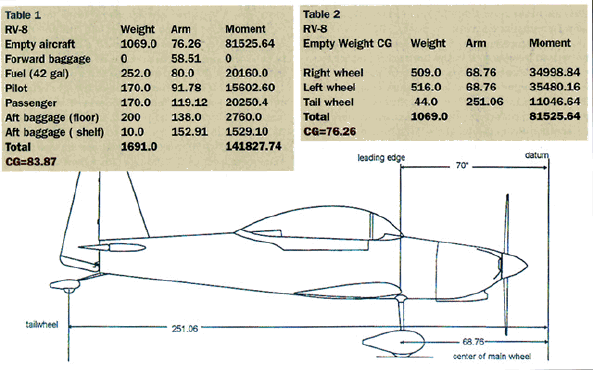Weight & Balance: Weighing and measuring your safety
By Ron Alexander (originally published in EAA Sport Aviation, March 2001)
Proper distribution of weight plays a large and important role in an aircraft’s overall performance. Load your airplane improperly, and it will affect its fuel consumption, speed, rate of climb, controllability, ceiling, and even structural integrity.
When building your own airplane, determining its weight and balance before its first flight is critical to your safety—and the safety of those who will fly with you. Take care and all the time necessary to determine accurate weight and balance numbers.
Like production aircraft, homebuilts must have accurate weight and balance data when they are certificated, and when the FAA examines your completed project, the inspector will want to see your weight and balance paperwork.
Most kit manufacturers and aircraft designers offer some weight and balance assistance by providing the airplane’s maximum gross weight, aerobatic gross weight (if applicable), maximum baggage weight for each compartment, the forward and aft center of gravity (CG) limits, the aerobatic CG range, and the datum reference point. It is your responsibility to weigh and calculate the numbers for your airplane.
Several designers also provide tables with sample weight and balance numbers showing typical loading situations. These are for your review only. Do not use them for your aircraft because the weight and balance numbers are different for every airplane, even if they are of the same make and model.
Just how deep must you get into weight and balance? Deep enough to tabulate the weight and balance data needed to get your airworthiness certificate—and to properly load your aircraft. As the pilot in command, Federal Aviation Regulation 91.7, Civil Aircraft Airworthiness, makes you responsible for determining whether your aircraft is safe to fly.
Part of your determination of an aircraft’s suitability for safe flight is making sure it is within its weight and balance limits and it does not exceed its maximum gross weight. You can’t determine that without calculating your airplane’s weight and balance numbers. Your aircraft’s weight and balance also plays a huge role in how safely it flies.
Performance & Safety
What effects can weight and balance have on an aircraft? If an airplane is heavier than its maximum gross weight, the airplane’s…
• takeoff run will be longer because the takeoff speed will be higher.
• rate and angle of climb performance will be reduced.
• loading during aerobatic flight will be excessive.
• cruising speed will be reduced.
• cruising range will be shortened.
• service ceiling will be lowered.
• maneuverability will be decreased.
• landing roll will be longer because the landing speed will be higher.
An airplane’s balance, where its center of gravity (CG) is located, is, perhaps, even more critical to the safety of flight because the CG’s location affects the airplane’s stability. An airplane’s center of gravity is the point where the airplane would balance if suspended from a wire, and it’s the point at which the airplane’s total weight is assumed to be concentrated (see Figure 1).
|
|
Figure 1 |
For safety, the CG must be within specific limits, as determined by the designer. Both lateral and longitudinal balance is important, but longitudinal balance—where the CG is between the nose and tail—is the prime concern.
If the CG is between the allowable limits, the airplane will have adequate stability and control. As the CG moves toward its aft limit, the elevator control pressures become lighter, making it easier to rotate to a higher than desired angle of attack, which can lead to a stall.
If the CG is at or ahead of its aft limit, the elevator should have the nose-down authority to recover from a stall. If the CG is behind its aft limit, the elevator probably will not have the nose-down authority to recover from the stall. Should the aircraft enter a spin with an aft CG, it could enter a flat spin from which recovery would be unlikely.
As the CG moves toward its forward limit, the elevator’s nose-up control pressures become heavier when applying nose-up forces, and you’ll need more nose-up elevator to maintain level flight. Because the elevator’s nose-up authority decreases as the CG moves forward, if the CG is ahead of its forward limit, the elevator may not have the nose-up authority to rotate for takeoff—or flare to land.
Weight and balance is so critical to the safety of flight that the FAA Aviation Safety Program created a document (FAA-P-8740-5) solely about it, and it offers the following:
“Aircraft performance and handling characteristics are affected by the gross weight and center of gravity limits. If every pilot were to understand and respect this fact, general aviation accidents could be reduced dramatically. An overloaded or improperly balanced aircraft will require more power and greater fuel consumption to maintain flight, and the stability and controllability will be seriously affected. Lack of appreciation for the effects of weight and balance on the performance of aircraft, particularly in combination with such performance reducing factors as high density altitude, frost or ice on the wings, low engine power, severe or uncoordinated maneuvers, and emergency situations, is a prime factor in many accidents.”
Calculating Weight & Balance
Weight and balance’s best analogy is a lever and fulcrum (think teeter-totter). If perfectly balanced on the fulcrum, the lever will be absolutely level. Adding any weight to the lever upsets the balance, and how much influence the weight has depends on its location on the lever. The greater the distance from the fulcrum, the greater the influence.
To regain the lever’s balance you must add some weight on the other side of the fulcrum (see Figure 2). The distance the weight is from the fulcrum is arm, and when you multiply the weight times the arm, you get the weight’s moment, or how much force it exerts (more on this later).
To make sure your airplane is in balance—that its CG is within its limits—you calculate its weight and balance for different configurations before flight to determine the CG’s location, mathematical proof that your airplane is properly loaded. Because you’re building your airplane, you will want to calculate several conditions to enable you to further calculate certain loads.
The weight and balance computations presented (Table 1) are for a typical RV-8, and the basic mantra for all weight and balance computation is: weight multiplied by arm equals moment. You fill in the spaces with the weights of the fuel, baggage, and occupants as appropriate, and then multiply them by the arm to get each item’s moment. (The empty weight, arm, and moment for your aircraft are constant, and you determine them when you weigh your homebuilt, which we’ll discuss next.)
To determine the location of the RV’s center of gravity, add up the totals of the weight and moment columns. Then divide the total moment (141,827.74) by the total weight (1,691) to get the CG’s location (141,827.74/1,691=83.87).
The RV-8’s CG range goes from 78.70 to 86.82 inches aft of datum, and 83.87 falls within the prescribed envelope. The RV’s maximum gross weight is 1,800 pounds, so 1,691 pounds is within that envelope. From these calculations we have mathematically proven our weight and balance data.
The CG’s location when you take off may not be the same as when you land because the fuel burned changes the weight at the fuel tanks’ station. In some aircraft the CG moves aft as fuel is consumed, and if the other weights in the aircraft are not properly loaded, the CG could be at or behind its aft limit when it’s time to land.
With a few simple calculations you can determine different loading scenarios for your airplane. You will want to compute sample loadings that result in these CG locations:
• Empty weight CG
• Typical loading with full fuel
• Typical loading with minimum fuel
• Most forward CG loading
• Most rearward CG loading
• Maximum loading with full fuel
• Maximum loading after flight with minimum fuel
Depending on your airplane, you may want to add other scenarios. For example, if your airplane is rated for aerobatics, you’d want to compute loadings that result in CG locations suitable for aerobatics. In either case, you calculate your airplane’s empty weight CG once—unless you add, subtract, or change its fixed equipment, and then you must figure it again.
Weighing Your Airplane
To determine your airplane’s empty weight and empty-weight center of gravity (EWCG), you must weigh it. And to weigh your airplane, you need to obtain the proper scales. Some builders use bathroom scales, but given the importance of accurate weight and balance information to the safety of every flight you make in the airplane, borrow or rent platform scales that have been calibrated for accuracy. (Certainly the safety of you and your passengers is worth the rental charge.)
|
|
|
A typical scale used for aircraft. If your scales are on wheels, make sure they are chocked securely so they won’t move when you roll your airplane onto them. |
In a hangar, where wind cannot blow on the aircraft and cause fluctuations in weight, weigh your airplane in its empty condition. Generally, “empty weight” means weight of the airframe, engines, all permanently installed (fixed) equipment, unusable (residual) fuel, undrainable oil, hydraulic fluid, and fixed ballast.
To keep track of what “fixed” equipment you’ve included in the empty weight, from engine and prop to wheel pants, create an equipment list. You should weigh your airplane in its ready-to-fly configuration, meaning all the cowlings, doors, canopies, etc. are in their in-flight positions.
Before you put the airplane on the scales, assemble all of the equipment you will need. This includes chocks, jacks, leveling equipment, plumb bobs, chalk lines, measuring tapes, etc. If needed, build ramps that will allow you to roll your airplane onto the scales. If your airplane is a taildragger, have a tailwheel compatible stand that will hold your airplane’s tail in a level-flight attitude.
When picking a hangar in which to weigh your airplane so it’s out of the wind, which can cause less than perfect accuracy, make sure the hangar has a smooth floor because you’ll be making some chalk lines on it. If your scales are on wheels (this is typical), make sure they are chocked securely so they won’t move when you roll your airplane onto them. When the airplane is on the scales, chock its wheels; don’t use the parking brake because it introduces errors. Make sure you weigh the airplane chocks before you weigh the airplane.
When on the scales make sure the airplane is in a level-flight attitude so all components will be at their correct distance from the datum, which results in the most accurate information. Use the leveling procedure recommended by the designer. Then record the weights indicated by the three scales (nosewheel or tailwheel, left main, and right main)—and then subtract the weight of the respective wheel chocks.
Don’t take your airplane off the scales after you weigh it—you need to measure the exact location of certain key components. The easiest and most accurate way to accomplish this is to use a plumb bob and chalk line. On the floor mark a chalk line that parallels the airplane’s centerline. Use a plumb bob to transfer the locations of the reference datum and the other components to the chalk line. Then measure the components’ distance from the datum. The designer should include a list of components, and this list typically includes seats, fuel tanks, baggage areas, and the main and nose/tailwheel.
A good way to make sure you record all the required weights and measurements is to create a form like Table 1 or 2. When the required weights and/or arm numbers are filled in, you’re done—with weighing and measuring. Now it’s time to do some math. (To make life even easier, create the tables using a spreadsheet program, such as Microsoft Excel, so it will do the math for you. As an added benefit, you can use the spreadsheet to compute your airplane’s weight and balance forever. All you have to do is plug in the numbers for the variable weights like passengers and baggage.)
Weight and balance math isn’t hard if you remember the W&B mantra: weight times arm equals moment. Table 2 uses hypothetical numbers for the RV-8, and after you compute the moment for each wheel, you total up the weight and moment columns. To find the empty-weight center of gravity, reverse the W&B mantra: divide the total moment by the total weight. Doing this for the numbers in Table 2 tells us that the RV-8’s EWCG is 76.26 inches from the reference datum (81,525.64/1,069=76.26).
You may note that the EWCG falls outside of the RV-8’s established CG envelope (78.70 to 86.82 inches aft of datum), but that’s okay because the RV won’t fly without a pilot, fuel, oil, etc. The weights of these essential components will bring the CG inside the envelope.
Ballast
In most cases, if you build your airplane according to the designer’s specifications and don’t add a lot of heavy equipment, your airplane CG should fall within the prescribed envelope. But if you make some changes, or you’re larger or smaller than the average person, you may have to add some ballast to make sure the CG stays safely in the envelope.
Ballast doesn’t always mean adding dead, worthless weight permanently to your airplane. Try relocating some weighty components, such as the battery. For example, if your airplane is too nose-heavy and the battery is under the cowling, move the battery aft. How far? The Aircraft Weight and Balance Handbook, FAA-H-8083-1, gives the required formulas and steps you through them.
Depending on your airplane, in some loading conditions you might need some temporary ballast to move the CG where it belongs (inside the envelope). The best solution is to add or subtract weight in the baggage compartment or to change the seating positions of passengers of different weights (if possible).
Accurately weighing, measuring, and computing your homebuilt’s weight and balance is the first step toward ensuring safe flight, first test flight or otherwise. Compute the various loading conditions that you may encounter with your airplane and have them ready for the FAA inspector when he or she inspects your airplane.
Remember that the weight and balance documentation is part of paperwork that must be on board at all times. It should show the empty weight, empty-weight CG, most forward and most rearward limits, and sample loadings. (The kit manufacturer or designer will provide the fore and aft CG limits and the maximum gross weight.)
Loading the aircraft properly is up to you, and it’s absolutely essential for safe operation. If you’re unsure whether the CG is in the envelope of safety, take the time to compute and verify its location.
References & Terms
Like other aspects of aviation, weight and balance has its own set of terms, and below are the more common ones. The definitions come from the FAA’s recently updated Aircraft Weight and Balance Handbook, FAA-H-8083-1.
In eight well-illustrated chapters, the handbook teaches almost everything pilots, maintenance technicians—and homebuilders—need to know about weight and balance, from theory and documentation to an excellent how-to description about weight and figuring an aircraft’s weight and balance. It’s available from most pilot supply stores and mail order companies.
Other good references are the FAA Aviation Safety Program pamphlet, “Weight and Balance,” FAA-P-8740-5, FAA Advisory Circular 43.13-1B, Acceptable Methods, Techniques, and Practices—Aircraft Inspection and Repair, and the FAA’s Airframe and Powerplant Mechanics General Handbook, AC 65-9A. These documents are available from the Government Printing Office and Government Book Stores, and all FAA documents and regulations are available on CD-ROM from Summit Aviation at www.summitaviation.com or by calling 800/328-6280.
Arm—Also called the Moment Arm and usually measured in inches, it is the horizontal distance from the reference datum to an item, such as the front passenger seats or aft baggage compartment. If the arm is measured aft of the datum, it has a plus (+) sign before the number, and all numbers will be positive if the datum is on the airplane’s nose. If the datum is the wing’s leading edge, arm measurements forward of this point are preceded by a minus (-) sign.
Center of Gravity (CG)—The point at which an aircraft would balance if suspended at that point. It is the center of the aircraft’s mass and the theoretical point where the aircraft’s weight is assumed to be concentrated. Its distance from the reference datum is determined by dividing the total moment by the aircraft’s total weight.
Center of Gravity Limits—The extreme forward and aft CG locations (measured in inches from the datum) within which the aircraft must be operated at a given weight to fly safely.
Empty-Weight Center of Gravity (EWCG)—An aircraft’s CG when it contains only the items specified in the aircraft empty weight. This number serves no purpose except to use as a basis for center of gravity computations with other items added. You calculate this number when you weigh the aircraft.
Empty Weight—The weight of the airframe, engines, all permanently installed (fixed) equipment, unusable (residual) fuel, undrainable oil, hydraulic fluid, and fixed ballast.
Leveling Datum—A point on the airframe where you can place a level to determine when the airplane is perfectly level for weighing.
Maximum Gross Weight—The maximum authorized weight of the aircraft and all its equipment. Established by the designer or kit manufacturer, it is a recommended weight that you should not exceed. The Aerobatic Gross Weight is the maximum weight the aircraft structure will support at the acrobatic aircraft category’s 6-G limit.
Mean Aerodynamic Chord (MAC)—The average distance from the leading edge to the trailing edge of the wing. Mostly used for large, swept-wing aircraft, the MAC is the average chord of an imaginary wing that has the same aerodynamic characteristics of the actual wing, and the aircraft’s center of gravity is expressed as a percentage of the MAC, which indicates the CG with respect to the wing itself.
Moment—A force that causes or tries to cause an object to rotate. This force is measured in pound-inches (lb/in) and is the product of the weight of an item multiplied by its arm. For example, 200 pounds of fuel located 40 inches from the datum line would have a moment of 8,000 lb/in. Total Moment is the weight of the aircraft multiplied by the distance between the datum and the CG.
Reference Datum—An imaginary vertical plane or line from which all horizontal distances (moment arms) are measured for balance purposes. There is no fixed rule about the datum’s location. Usually it’s on the airplane’s nose (point of the spinner) or the leading edge of the wings.
Station—A location along the aircraft fuselage, usually measured in inches from the datum.
Useful Load—The difference between the aircraft’s empty and maximum weight. It is the weight an aircraft can carry as usable fuel and oil, passengers, and baggage.




